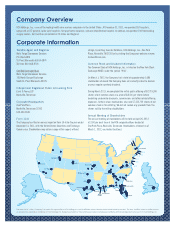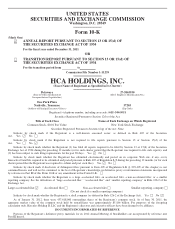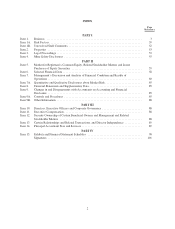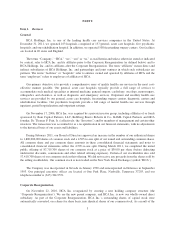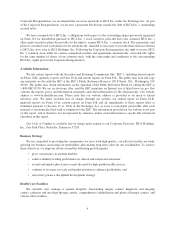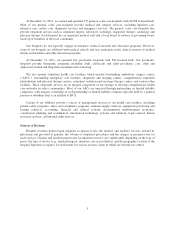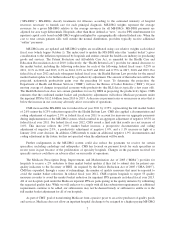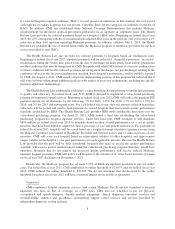HCA Holdings 2011 Annual Report Download - page 11
Download and view the complete annual report
Please find page 11 of the 2011 HCA Holdings annual report below. You can navigate through the pages in the report by either clicking on the pages listed below, or by using the keyword search tool below to find specific information within the annual report.
if a selected hospital acquired condition (“HAC”) was not present on admission. In this situation, the case is paid
as though the secondary diagnosis was not present. Currently, there are ten categories of conditions on the list of
HACs. In addition, CMS has established three National Coverage Determinations that prohibit Medicare
reimbursement for erroneous surgical procedures performed on an inpatient or outpatient basis. The Health
Reform Law provides for reduced payments based on a hospital’s HAC rates. Beginning in federal fiscal year
2015, the 25% of hospitals with the worst national risk-adjusted HAC rates in the previous year will receive a 1%
reduction in their total inpatient operating Medicare payments. In addition, effective July 1, 2011, the Health
Reform Law prohibits the use of federal funds under the Medicaid program to reimburse providers for medical
services provided to treat HACs.
The Health Reform Law also provides for reduced payments to hospitals based on readmission rates.
Beginning in federal fiscal year 2013, inpatient payments will be reduced if a hospital experiences “excessive”
readmissions within the 30-day time period from the date of discharge for heart attack, heart failure, pneumonia
or other conditions that may be designated by CMS. Hospitals with what CMS defines as excessive readmissions
for these conditions will receive reduced payments for all inpatient discharges, not just discharges relating to the
conditions subject to the excessive readmission standard. Each hospital’s performance will be publicly reported
by CMS. On August 1, 2011, CMS issued a final rule implementing portions of this program but indicated that it
will issue in future rulemakings additional policies with respect to excessive readmissions, including the specific
payment adjustment methodology.
The Health Reform Law additionally establishes a value-based purchasing program to further link payments
to quality and efficiency. In federal fiscal year 2013, HHS is directed to implement a value-based purchasing
program for inpatient hospital services. Beginning in federal fiscal year 2013, CMS will reduce the inpatient PPS
payment amount for all discharges by the following: 1% for 2013; 1.25% for 2014; 1.5% for 2015; 1.75% for
2016; and 2% for 2017 and subsequent years. For each federal fiscal year, the total amount collected from these
reductions will be pooled and used to fund payments to reward hospitals that meet certain quality performance
standards established by HHS. The Health Reform Law provides HHS with considerable discretion over the
value-based purchasing program. On April 29, 2011, CMS issued a final rule establishing the value-based
purchasing program for hospital inpatient services. Under this final rule, CMS estimates it will distribute
$850 million in federal fiscal year 2013 to hospitals based on their overall performance on a set of quality
measures that have been linked to improved clinical processes of care and patient satisfaction. For payments in
federal fiscal year 2013, hospitals will be scored based on a weighted average of patient experience scores using
the Hospital Consumer Assessment of Healthcare Providers and Systems survey and 12 clinical process-of-care
measures. CMS will score each hospital based on achievement (relative to other hospitals) and improvement
ranges (relative to the hospital’s own past performance) for each applicable measure. Because the Health Reform
Law provides that the pool will be fully distributed, hospitals that meet or exceed the quality performance
standards will receive greater reimbursement under the value-based purchasing program than they would have
otherwise. Hospitals that do not achieve the necessary quality performance will receive reduced Medicare
inpatient hospital payments. CMS will notify each hospital of the amount of its value-based incentive payment
for fiscal year 2013 discharges on November 1, 2012.
Historically, the Medicare program has set aside 5.10% of Medicare inpatient payments to pay for outlier
cases. For federal fiscal year 2011, CMS established an outlier threshold of $23,075, and for federal fiscal year
2012, CMS reduced the outlier threshold to $22,385. We do not anticipate that the decrease to the outlier
threshold for federal fiscal year 2012 will have a material impact on our results of operations.
Outpatient
CMS reimburses hospital outpatient services (and certain Medicare Part B services furnished to hospital
inpatients who have no Part A coverage) on a PPS basis. CMS uses fee schedules to pay for physical,
occupational and speech therapies, durable medical equipment, clinical diagnostic laboratory services and
nonimplantable orthotics and prosthetics, freestanding surgery center services and services provided by
independent diagnostic testing facilities.
8


